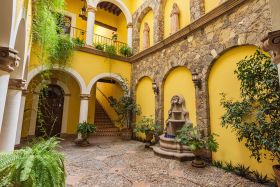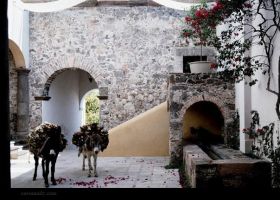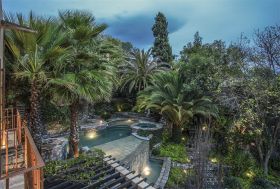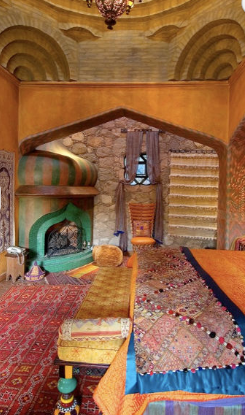What are the construction standards in San Miguel de Allende?
Lane Simmons - RE/MAX Colonial San Miguel de Allende
 If you are in the historic central zone there are very strict requirements about what you can and cannot do. For example, if you want to paint the front of your building, you have a selection of pastel colors to choose from; you cannot just decide a certain color for your building.
If you are in the historic central zone there are very strict requirements about what you can and cannot do. For example, if you want to paint the front of your building, you have a selection of pastel colors to choose from; you cannot just decide a certain color for your building.However, in most areas outside the center of San Miguel, we are seeing some contemporary construction, which often appeals more to Mexican buyers for whom colonial style architecture is not such a...
 If you are in the historic central zone there are very strict requirements about what you can and cannot do. For example, if you want to paint the front of your building, you have a selection of pastel colors to choose from; you cannot just decide a certain color for your building.
If you are in the historic central zone there are very strict requirements about what you can and cannot do. For example, if you want to paint the front of your building, you have a selection of pastel colors to choose from; you cannot just decide a certain color for your building.However, in most areas outside the center of San Miguel, we are seeing some contemporary construction, which often appeals more to Mexican buyers for whom colonial style architecture is not such a big deal.
There are height restrictions as well. The general rule is an 8.5-meter height restriction pretty much anywhere that you are building in the urban areas.
San Miguel de Allende also has a construction permitting process. If you are going to construct something, particularly in the city or its suburbs, you need to obtain permits before you are able to build, but out in the countryside you can do just about whatever you want. The permitting process is somewhat similar to in the States. To apply for the construction permit, an architect who is among the officially recognized architects of San Miguel has to submit your plans for approval by the office of Urban Development.
By the time you get the construction permit, you are pretty certain that what you are intending to build is going to be well constructed. Of course a major reason for the construction permits is because when you are done, you have to close the construction permit, and in order to do this the city sends someone to inspect to see that everything was done correctly, and to make sure that the city’s assessment of the value of any new construction is recorded in the municipal tax records to increase your annual property taxes accordingly. They also want to make certain that Social Security contributions were paid for the construction workers.
After more than 20 years of being here in Mexico, I can generally look at construction and tell you whether or not there is something to be concerned about, but I usually recommend getting an inspection done by someone reputable who specializes in this.
Often an interesting detail in this regard is the age of existing construction here. Through my international affiliations I am able to get property listings here placed in MLS systems in the US. The related forms always ask for the age of construction, and I wonder what people might think when I have to put the age of construction at 400 years, but frequently at least some of the property’s construction is in that age range.
The average gringo probably thinks that the older the construction, the more likely you will have a problem. I tell people that here what I am worried about is any construction that is less than two years old.
The best way I can think of to describe construction here it is to say that it’s almost always and all ways a custom job, manually done, as opposed to basically just being assembled from prefabricated materials. The workers usually hand mix the cement right there. Since the construction primarily consists of block and steel, brick, cement, stone, etc., the weight of a home here is enormous. So in the first year or two, a building may experience some settling, and could get cracks where something sagged, but because of the nature of the construction, usually you can just fill in the crack, plaster over it, and you’re good to go.
(Courtyard home near the central plaza, San Miguel Allende, Mexico
Posted May 4, 2016
Eric Chazaro - Keller Williams Allende
 The way of building here in Mexico is completely different from the way of building in the United States and Canada. The main difference is on the type of materials that are used in building. The homes in San Miguel de Allende are made out of solid concrete and brick. All the constructions that you see here in San Miguel de Allende would have concrete walls or brick walls and solid stucco and incredible boveda ceilings, which are vaulted ceilings that are very popular here.
The way of building here in Mexico is completely different from the way of building in the United States and Canada. The main difference is on the type of materials that are used in building. The homes in San Miguel de Allende are made out of solid concrete and brick. All the constructions that you see here in San Miguel de Allende would have concrete walls or brick walls and solid stucco and incredible boveda ceilings, which are vaulted ceilings that are very popular here.  The way of building here in Mexico is completely different from the way of building in the United States and Canada. The main difference is on the type of materials that are used in building. The homes in San Miguel de Allende are made out of solid concrete and brick. All the constructions that you see here in San Miguel de Allende would have concrete walls or brick walls and solid stucco and incredible boveda ceilings, which are vaulted ceilings that are very popular here.
The way of building here in Mexico is completely different from the way of building in the United States and Canada. The main difference is on the type of materials that are used in building. The homes in San Miguel de Allende are made out of solid concrete and brick. All the constructions that you see here in San Miguel de Allende would have concrete walls or brick walls and solid stucco and incredible boveda ceilings, which are vaulted ceilings that are very popular here. There are certain regulations that you have to follow when you are building in San Miguel de Allende because this is a protected area. The regulations are mostly on the height and style of construction. As you go out of the main square of the city of San Miguel, and out of the historic center, then you will start seeing some more Mexican contemporary or even contemporary buildings. But in general, people who come to San Miguel de Allende do like the “colonial” style of the building here. The building styles here are really colonial and a mix of Mexican and colonial, which is a style that has become “San Miguel style”.
You will see buildings with bovedas and incredible landscaping, which is really big here. There are some gardening clubs here in San Miguel de Allende that some of the expats love to join. There are no buildings in San Miguel de Allende that is over three stories high. Everything has to stay below 9 meters (about 30 feet) tall as part of the building restrictions here in San Miguel de Allende. It is pretty much a flat city unless you are in downtown San Miguel where you would see the antique historical buildings that are really high but in general, most people who build in San Miguel keep it at one or two levels and build horizontally rather than vertically.
(Pictured: a vaulted ceiling, known as a boveda, in a residence in San Miguel de Allende, Mexico.)
Posted June 12, 2016
Clementina Beas
 In general, the construction of homes in San Miguel de Allende is very solid. However, it’s really important for people who are considering purchasing a home in San Miguel to review the foundation of the home before they purchase to make sure that there are no tunnels, especially if they live in “Centro” (the central area) where tunnels have been constructed underneath the homes. Potential buyers should also ensure that there are no subterranean waterways that could...
In general, the construction of homes in San Miguel de Allende is very solid. However, it’s really important for people who are considering purchasing a home in San Miguel to review the foundation of the home before they purchase to make sure that there are no tunnels, especially if they live in “Centro” (the central area) where tunnels have been constructed underneath the homes. Potential buyers should also ensure that there are no subterranean waterways that could... In general, the construction of homes in San Miguel de Allende is very solid. However, it’s really important for people who are considering purchasing a home in San Miguel to review the foundation of the home before they purchase to make sure that there are no tunnels, especially if they live in “Centro” (the central area) where tunnels have been constructed underneath the homes. Potential buyers should also ensure that there are no subterranean waterways that could affect the foundation of the home that they’re considering to purchase.
In general, the construction of homes in San Miguel de Allende is very solid. However, it’s really important for people who are considering purchasing a home in San Miguel to review the foundation of the home before they purchase to make sure that there are no tunnels, especially if they live in “Centro” (the central area) where tunnels have been constructed underneath the homes. Potential buyers should also ensure that there are no subterranean waterways that could affect the foundation of the home that they’re considering to purchase. If there’s a basement in the home that the person is considering purchasing, they really have to look into the presence of waterways that could potentially be adjacent to the home, because there have been issues with water leakage into homes, especially those that have subterranean basement-type construction. This type of water damage affects the health of the people who live in the home, and cause damage to the foundation of the home, and potential damage to furniture and electronic equipment.
Unfortunately, home insurance does not cover damages caused by waterways if the home is built in an area where there are waterways that affect the construction, so it’s really important for a home owner to be able to look into this ahead of time, and ensure that there isn’t going to be any potential damage. This is based on the experience that we’ve had with clients who do have, or have had problems with water filtration, and have tried to make home insurance claims but have been denied.
San Miguel de Allende is in a non-seismic zone, but a volcanic eruption in Puebla or Colima can potentially cause an earthquake here in San Miguel. That’s why it’s really important that people check the foundation of the home to make sure that it’s built solidly. Although we don’t live in an earthquake zone, I still recommend that homeowners do consider this potential risk.
(Courtyard in San Miguel de Allende, Mexico, pictured.)
Posted November 13, 2016
Nancy Howze - CDR Bienes Raices San Miguel, SC
 The construction standards in San Miguel de Allende are very strict if you are building in the historic center. In the historic center, you cannot knock down old walls, and you can’t put in a window or a garage if there wasn’t one beforehand.
The construction standards in San Miguel de Allende are very strict if you are building in the historic center. In the historic center, you cannot knock down old walls, and you can’t put in a window or a garage if there wasn’t one beforehand. In many cities such as the historic area of Charleston in South Carolina, they have very strict codes in order to maintain the historic character of the area. For instance, you have to paint using...
 The construction standards in San Miguel de Allende are very strict if you are building in the historic center. In the historic center, you cannot knock down old walls, and you can’t put in a window or a garage if there wasn’t one beforehand.
The construction standards in San Miguel de Allende are very strict if you are building in the historic center. In the historic center, you cannot knock down old walls, and you can’t put in a window or a garage if there wasn’t one beforehand. In many cities such as the historic area of Charleston in South Carolina, they have very strict codes in order to maintain the historic character of the area. For instance, you have to paint using only certain colors and not change the historic aspect of the town center. The same holds true here in San Miguel de Allende.
The houses in San Miguel de Allende are built very differently than in the US. They’re not built with stick construction or framing, which means these houses are very well-built. The homes in San Miguel de Allende are built on the high end; they’re built to last. In fact, some of the houses in San Miguel de Allende have been here for 300-400 years. I lived in Alabama where homes get blown away all the time by tornados, and where on the coastline, homes get blown away by hurricanes.
The construction code in San Miguel de Allende doesn't allow you to build over the city height limit, which is 8.3 meters (about 27 feet). There is also no OSHA (Occupational Safety and Health Administration) in San Miguel de Allende. If you want to build a window all the way to the floor, that’s fine. You don’t have to have double paned glass in it, or follow some of the rules of OSHA as do many people in the United States. There are no rules and regulations pertaining to how you build specifically. In the United States, for example, one of the rules is that the riser or the steps can be no more than 7 inches. There’s no standard like that here in San Miguel de Allende-- you can make it lower or higher depending on what you want.
One of my favorite things about building in San Miguel de Allende is that the homes are hand-made. This is a “can-do” country; Mexicans can do anything. But if you, as the person who’s building a new house, are expecting perfection, you’re in the wrong country. Everything in San Miguel de Allende is made by hand, and hands don’t make things the way machines do. They don’t stamp it out. For me, that’s the beauty here in San Miguel de Allende. There’s nothing more wonderful than looking at a home and seeing the imperfections. For example, on the fireplace here in my office, you can see imperfections on the stone, which is a joy to see because it makes you think you don’t have to be perfect to live in San Miguel de Allende.
(Terraced home, San Miguel de Allende, Mexico, pictured.)
Posted December 22, 2016
Ariadna Delsol - COLONIAL REAL ESTATE
 If you are going to build in San Miguel de Allende, it should not be higher than 8 meters. If you are going to buy a property in Centro, you cannot alter the façade of the house without asking for permission from the government. If you are buying a historical building, whether it is a torn down building or a fixer upper, the government will not let you tear down a building unless it is really crumbling down. If you buy a building that is already crumbling down, whatever you...
If you are going to build in San Miguel de Allende, it should not be higher than 8 meters. If you are going to buy a property in Centro, you cannot alter the façade of the house without asking for permission from the government. If you are buying a historical building, whether it is a torn down building or a fixer upper, the government will not let you tear down a building unless it is really crumbling down. If you buy a building that is already crumbling down, whatever you... If you are going to build in San Miguel de Allende, it should not be higher than 8 meters. If you are going to buy a property in Centro, you cannot alter the façade of the house without asking for permission from the government. If you are buying a historical building, whether it is a torn down building or a fixer upper, the government will not let you tear down a building unless it is really crumbling down. If you buy a building that is already crumbling down, whatever you will do to it has to be approved by INAH, which is a commission that approves or disapproves any changes to the façade of the buildings in San Miguel. If you want to remodel a building that is not in Centro, you can do whatever you want but if you are buying in Centro, you will need to get permission before you change or do anything to the structure.
If you are going to build in San Miguel de Allende, it should not be higher than 8 meters. If you are going to buy a property in Centro, you cannot alter the façade of the house without asking for permission from the government. If you are buying a historical building, whether it is a torn down building or a fixer upper, the government will not let you tear down a building unless it is really crumbling down. If you buy a building that is already crumbling down, whatever you will do to it has to be approved by INAH, which is a commission that approves or disapproves any changes to the façade of the buildings in San Miguel. If you want to remodel a building that is not in Centro, you can do whatever you want but if you are buying in Centro, you will need to get permission before you change or do anything to the structure. If you build in San Miguel you can have an inspector come to see that there are no cracks on the walls, that the ceiling is not bowed, they will check the electrical outlets, etc. There is definitely an inspector appointed by the City Hall but if you were to buy a house that is already constructed and you hire your own inspector, it would be a little bit harder for him to determine if the house is really badly built. I would recommend for anyone to get an inspector to check electrical outlets, sewage and plumbing, heater, gas tank, etc.
In general, the houses here in San Miguel are well-built because the City Hall appoints an inspector to make sure that everything is built to code. For old houses, you have to have an architect to tell you if the wall is still strong enough to last for another hundred years. In general, even the old buildings here in San Miguel are well-built because of the way they did construction in the past. They used really thick walls and the materials were stronger.
If you go to a lower-income development that sells cheap houses or the ones that are priced less than US $100,000, you will notice that they use tiny rebar and very thin walls. That doesn’t happen here in San Miguel.
(Two-foot solid adobe walls on stone and vaulted ceiling in a centro home, San Miguel de Allende,Mexico, pictured.)
Posted February 17, 2017
Greg Gunter - Dream Pro Homes
.jpg) Construction standards are broadly defined, Readers, speaking to you as an architect turned Realtor. Let’s talk about what that might mean.
Construction standards are broadly defined, Readers, speaking to you as an architect turned Realtor. Let’s talk about what that might mean. The type of construction here in San Miguel de Allende, as in most all of Mexico, is overwhelmingly reinforced-concrete structural components infilled with red brick or sometimes adobe brick, with cast-concrete floors and roofs. Almost without exception, any wood you see in a home is ornamental (those viga...
.jpg) Construction standards are broadly defined, Readers, speaking to you as an architect turned Realtor. Let’s talk about what that might mean.
Construction standards are broadly defined, Readers, speaking to you as an architect turned Realtor. Let’s talk about what that might mean. The type of construction here in San Miguel de Allende, as in most all of Mexico, is overwhelmingly reinforced-concrete structural components infilled with red brick or sometimes adobe brick, with cast-concrete floors and roofs. Almost without exception, any wood you see in a home is ornamental (those viga beams we all love are just decorative, for example). That means the homes are uninsulated, which can be problematic in a cold winter if your home was not designed with any consciousness of the solar orientation of the home. Conversely, it has positive benefits: the structural component of a wall is at the top of the wall and usually spans the entire room. If you want to double the width of a door or window, it’s easy to do!
However, if you want to discuss construction standards as they might compare to the U.S., there is little if any building code that builders must adhere to as they must in the U.S. You will seldom see electrical outlets placed every eight feet along a wall, seldom see GFI outlets in the bathrooms and kitchen, stair treads considered life-threatening and illegal in the U.S. are par for the course here, handrails are a bonus not an expectation and, well, you get the picture. The homes here are often (although not always) well built, just not to the same standards to which you might be accustomed. The good news is that if you don’t like running a 15-foot extension cord across your living room, adding a new outlet is very inexpensive!
Be sure to work with a good Realtor (maybe one who is also an architect!) who will guide you through these issues and expectations, and who can steer you to the best home inspector!
Posted April 18, 2017


